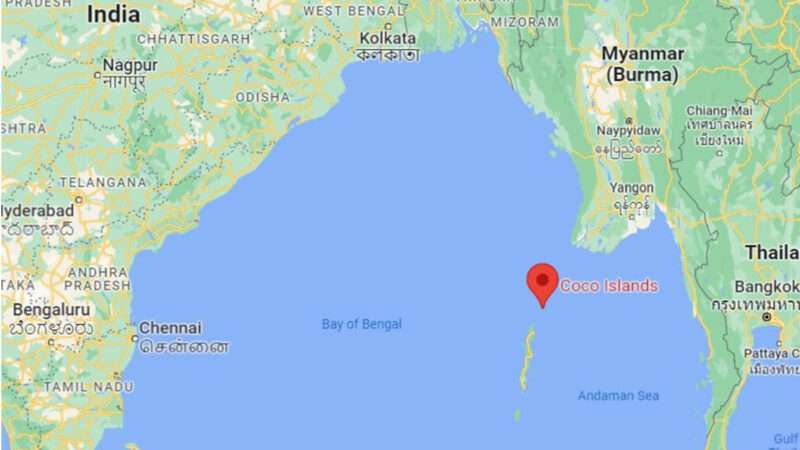The Andaman and Nicobar Islands are one of India’s most strategically significant territories. Located in the Bay of Bengal, they host India’s most secretive and powerful naval bases, including sites capable of harboring nuclear powered submarines. Less than 100 kilometers to the north of these islands is a small chain of islands called Coco Islands, which has recently become a focal point of increasing tension, involving India, China and Myanmar. The developments on the Coco Islands could significantly change the security paradigm in the Bay of Bengal.
The Coco Islands have a history that dates to the early 1990s, when Indian intelligence first began to suspect that China was secretly building a listening post on the Coco Islands. Because of their proximity to India’s Andaman and Nicobar bases, the Coco Islands would have an ideal position to intercept signals associated with India’s missile tests, submarine operations and other sensitive military activities. For years, this was only suspicion. Some deemed the suspicion plausible while others deemed it paranoia. In 2005, the Indian Navy Chief publicly stated that there was no Chinese presence on the Coco Islands. The junta in Myanmar even hosted Indian officials and invited them to visit the islands.
The storyline drastically changed in 2023 when Maxar Technologies satellite photographs are making the rounds of a significant construction endeavor on Coco Islands. The satellite images showed a runway that sprawled out to 2,300 meters, newly built hangars, accommodation blocks, and even a causeway joining the Coco Islands with islands in close proximity. This large-scale undertaking indicated that there was not a minor infrastructure development occurring but instead the modernization of military bases. Although Myanmar contended that no Chinese had ever been involved, concerns grew among Indian officials. This construction was tied to the timing of Chinese engagement in the Indian Ocean from Hambantota in Sri Lanka to Gwadar in Pakistan, and perhaps now coco islands in Myanmar.
Tensions re-emerged during India’s yearly defense dialogue with Myanmar in September 2025. The Indian Defense Secretary Rajesh Kumar Singh went to Myanmar for talks, and the Myanmar junta reassured him that there were no Chinese nationals in Coco Islands. Although this looked positive, when India requested to send naval personnel to look at the island, it did not hear back. In New Delhi, the lack of communication caused concern as available satellite imagery indicates that new runways, barracks for over 1,000 personnel, and causeways to the nearby islands were being constructed.
The implications of any Chinese presence on Coco Islands would be strategic, beyond the island. The Chinese presence and coastline encirclement are part of a more comprehensive strategy to increase influence across the Indian Ocean. Already China operates a naval base in Djibouti near the Red Sea, operates the Hambantota port in Sri Lanka, and operates Gwadar port in Pakistan, and is building new ports in Bangladesh and Myanmar. Some have perceived this as what may help refer to the “triangle of death”, which would continue to box in India’s coastline and improve Chinese monitoring of vessels in the maritime space. Coco Islands could contribute to a listening post in the triangle of death and may further improve Chinese surveillance capacity in India’s very own backyard.
The Bay of Bengal represents a vital maritime conduit, linking the Middle East and Africa, China, Japan, and Korea. Nearly half of the world’s trade moves through this region. Thus, dominance over the Bay of Bengal means significant power over global pathways for trade. China’s Yunnan province is connected to the Kyaukpyu deep-sea port in Myanmar through the China-Myanmar Economic Corridor, allowing the movement of goods, including vital strategic materials, to reach the Indian Ocean without passing through the vulnerable Strait of Malacca. While Yunnan is landlocked and cannot send ships directly, goods and equipment can be moved overland to Kyaukpyu and then shipped, circumventing India’s naval watch towards Southeast Asia.
In response, India has adopted a cautious but proactive approach. New Delhi is enhancing surveillance from the Andaman and Nicobar Islands, expanding naval capacity in the Bay of Bengal, and closely monitoring developments on the Coco Islands. The fundamental question remains: if Myanmar truly has nothing to hide, why deny the Indian Navy access to inspect the island? Should the satellite reports prove accurate, China could be operating a listening post just minutes away from India’s most sensitive defense installations.
This situation highlights a broader truth about modern geopolitics: global power games are increasingly played not with conventional weapons, but with antennas, radar dishes, and silent signals transmitted through the air. Koko Islands may be small, but they sit at the heart of a silent strategic contest between India and China one that could shape the security dynamics of the entire Bay of Bengal for years to come.

